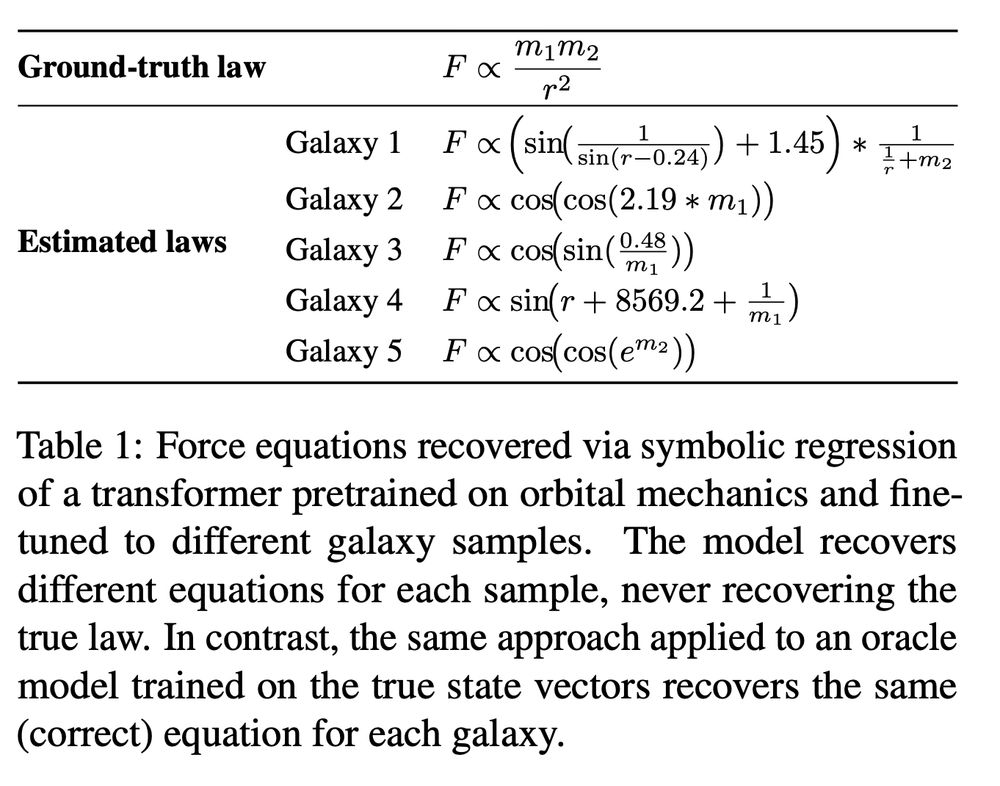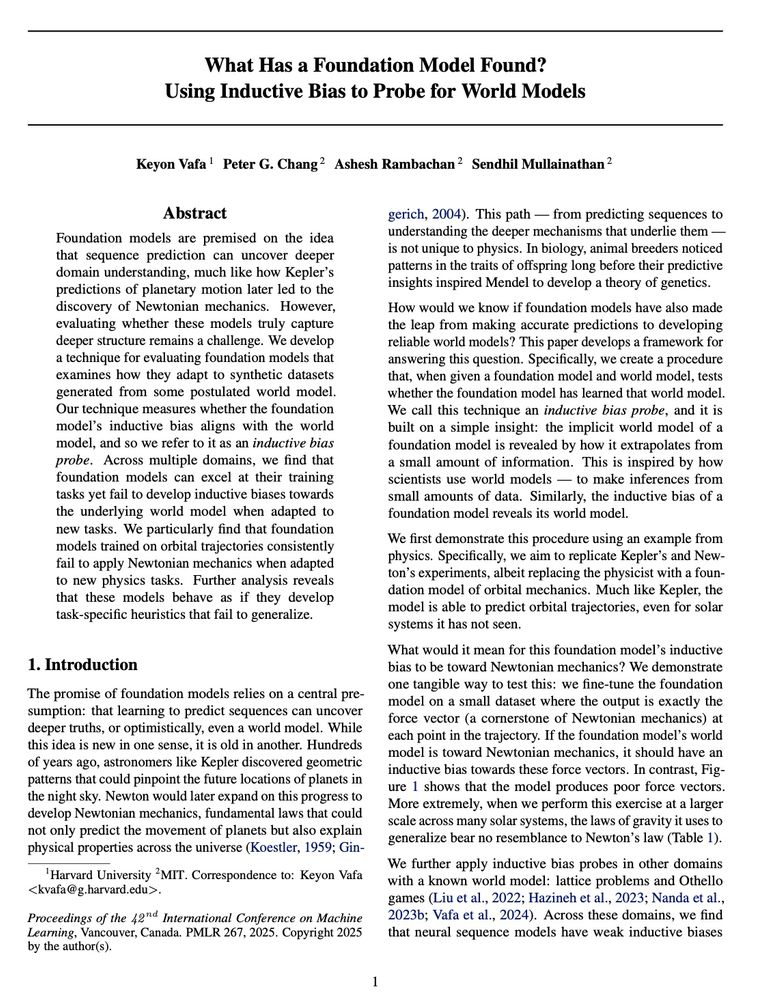https://keyonvafa.com
Co-authors: Peter Chang, Ashesh Rambachan (@asheshrambachan.bsky.social), Sendhil Mullainathan (@sendhil.bsky.social)

Co-authors: Peter Chang, Ashesh Rambachan (@asheshrambachan.bsky.social), Sendhil Mullainathan (@sendhil.bsky.social)
Plug: If you're interested in more, check out the Workshop on Assessing World Models I'm co-organizing Friday at ICML www.worldmodelworkshop.org

Plug: If you're interested in more, check out the Workshop on Assessing World Models I'm co-organizing Friday at ICML www.worldmodelworkshop.org
We now think that studying behavior on new tasks better captures what we want from foundation models: tools for new problems.
It's what separates Newton's laws from Kepler's predictions.
arxiv.org/abs/2406.03689

We now think that studying behavior on new tasks better captures what we want from foundation models: tools for new problems.
It's what separates Newton's laws from Kepler's predictions.
arxiv.org/abs/2406.03689
1. We propose inductive bias probes: a model's inductive bias reveals its world model
2. Foundation models can have great predictions with poor world models
3. One reason world models are poor: models group together distinct states that have similar allowed next-tokens
1. We propose inductive bias probes: a model's inductive bias reveals its world model
2. Foundation models can have great predictions with poor world models
3. One reason world models are poor: models group together distinct states that have similar allowed next-tokens
Models are much likelier to conflate two separate states when they share the same legal next-tokens.

Models are much likelier to conflate two separate states when they share the same legal next-tokens.
Even when the model reconstructs boards incorrectly, the reconstructed boards often get the legal next moves right.
Models seem to construct "enough of" the board to calculate single next moves.

Even when the model reconstructs boards incorrectly, the reconstructed boards often get the legal next moves right.
Models seem to construct "enough of" the board to calculate single next moves.
One hypothesis: models confuse sequences that belong to different states but have the same legal *next* tokens.
Example: Two different Othello boards can have the same legal next moves.
One hypothesis: models confuse sequences that belong to different states but have the same legal *next* tokens.
Example: Two different Othello boards can have the same legal next moves.
Inductive biases are great when the number of states is small. But they deteriorate quickly.
Recurrent and state-space models like Mamba consistently have better inductive biases than transformers.

Inductive biases are great when the number of states is small. But they deteriorate quickly.
Recurrent and state-space models like Mamba consistently have better inductive biases than transformers.
We tried providing o3, Claude Sonnet 4, and Gemini 2.5 Pro with a small number of force magnitudes in-context w/o saying what they are.
These LLMs are explicitly trained on Newton's laws. But they can't get the rest of the forces.


We tried providing o3, Claude Sonnet 4, and Gemini 2.5 Pro with a small number of force magnitudes in-context w/o saying what they are.
These LLMs are explicitly trained on Newton's laws. But they can't get the rest of the forces.
We used a symbolic regression to compare the recovered force law to Newton's law.
It not only recovered a nonsensical law—it recovered different laws for different galaxies.

We used a symbolic regression to compare the recovered force law to Newton's law.
It not only recovered a nonsensical law—it recovered different laws for different galaxies.
A model that understands Newtonian mechanics should get these. But the transformer struggles.

A model that understands Newtonian mechanics should get these. But the transformer struggles.
When we fine-tune it to new tasks, its inductive bias isn't toward Newtonian states.
When it extrapolates, it makes similar predictions for orbits with very different states, and different predictions for orbits with similar states.

When we fine-tune it to new tasks, its inductive bias isn't toward Newtonian states.
When it extrapolates, it makes similar predictions for orbits with very different states, and different predictions for orbits with similar states.
Starting with orbits: we encode solar systems as sequences and train a transformer on 10M solar systems (20B tokens)
The model makes accurate predictions many timesteps ahead. Predictions for our solar system:
Starting with orbits: we encode solar systems as sequences and train a transformer on 10M solar systems (20B tokens)
The model makes accurate predictions many timesteps ahead. Predictions for our solar system:
Two steps:
1. Fit a foundation model to many new, very small synthetic datasets
2. Analyze patterns in the functions it learns to find the model's inductive bias

Two steps:
1. Fit a foundation model to many new, very small synthetic datasets
2. Analyze patterns in the functions it learns to find the model's inductive bias
A good foundation model should do the same.
The No Free Lunch Theorem motivates a test: Every foundation model has an inductive bias. This bias reveals its world model.
A good foundation model should do the same.
The No Free Lunch Theorem motivates a test: Every foundation model has an inductive bias. This bias reveals its world model.
But Newton's laws went beyond orbits: the same laws explain pendulums, cannonballs, and rockets.
This motivates our framework: Predictions apply to one task. World models generalize to many
But Newton's laws went beyond orbits: the same laws explain pendulums, cannonballs, and rockets.
This motivates our framework: Predictions apply to one task. World models generalize to many
Before we had Newton's laws of gravity, we had Kepler's predictions of planetary orbits.
Kepler's predictions led to Newton's laws. So what did Newton add?

Before we had Newton's laws of gravity, we had Kepler's predictions of planetary orbits.
Kepler's predictions led to Newton's laws. So what did Newton add?
1. What's the difference between prediction and world models?
2. Are there straightforward metrics that can test this distinction?
Our paper is about AI. But it's helpful to go back 400 years to answer these questions.

1. What's the difference between prediction and world models?
2. Are there straightforward metrics that can test this distinction?
Our paper is about AI. But it's helpful to go back 400 years to answer these questions.

